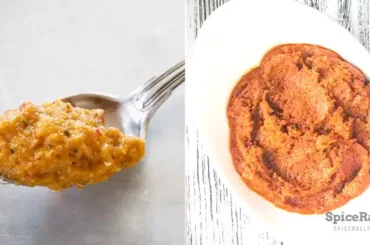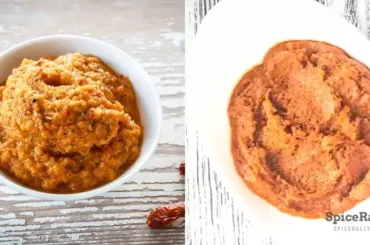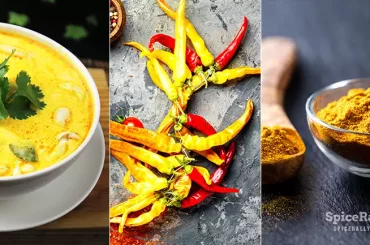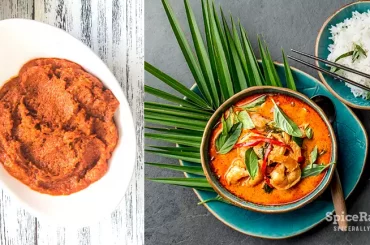At a glance, You might see that these two curry pastes are different in color. But actually, that is not the only way that Thai green curry paste and yellow curry paste differ. Therefore, you will get your doubts cleared with this feature.
The main difference between these two curry pastes comes down to their colors. Moreover, Thai green curry paste has green chilies as its base which is countable for its spicy, warm, and herbal undertone. While on the contrary, Thai yellow curry paste holds a less spicy, warm, and “curry” flavor due to its turmeric and curry powder/spices base.
On this note, let’s further check out what similarities and differences these two curry pastes possess.
Thai Green Curry Paste Vs Yellow Curry Paste- Difference Elaborated
If you are someone who adores giving a try to Asian dishes more often, the difference between these two curry pastes might have concerned you. In fact, they are different and unique in their own ways.

Above all, their flavor profiles, spiciness, and usage in cooking have significant differences that we believe are important when incorporating with the dishes. Thus, if you already have these pastes at home or are hoping to buy or make them, the table below will be super worthy!
So, look into our comparison chart here, where we have enlightened you with the facts about Thai green curry paste vs yellow curry paste.
| Thai Green Curry Paste | Thai Yellow Curry Paste | |
|---|---|---|
| Base Flavor | Green chilies | Turmeric and spices/ curry powder |
| Types of chilies used | Green chilies | Dried yellow/red chilies (in a small quantity) |
| Other Ingredients | Green chilies Cumin seeds Coriander seeds Garlic Galangal/ Ginger White pepper/ black pepper Coriander root (cilantro root) Lemongrass Turmeric Thai basil leaves Coriander leaves Kaffir lime peel Shrimp paste Salt Shallots Traces of fish | Turmeric Ground coriander Ground cumin Curry powder Garlic White pepper/black pepper Galangal/ginger Lemongrass Salt Fenugreek seeds Cardamom Mace Cinnamon Cloves Kaffir lime peel/kaffir lime leaves Shrimp paste Shallots |
| Flavor Profile | Spicy, warm with herbal, salty, and sour flavor notes. | Somewhat spicy (not biting). It has a warm hint with a strong “curry” punch. |
| Color | Light, medium, or dark green | Has a golden yellow tint. |
| Level of spiciness | Spicier than the yellow curry paste | Less spicy than the green curry paste |
| Availability | – It can be homemade or bought from the store. – Widely available in leading supermarkets, Asian grocery stores, local grocers, and online shopping sites. | – Can be purchased as pre-packaged ones or can be made at home. – Broadly available in Asian groceries, leading supermarkets, online shopping platforms, and local grocery stores |
| Forms of availability | It comes to the table in the form of a paste in different containers of various sizes and shapes. | This comes as a paste form in containers of different quantities and shapes. |
| Uses | – In curries including traditional Thai green curries – With meat, fish, and other seafood -To be incorporated with vegetables – With eggs – As a base in soups – To be mixed in with stews – In rice, noodles, spaghetti, and pasta dishes – With stir-fries – In salad dressings – To be combined in dipping sauces – As a taste enhancer in marinades – In wrap fillings and sandwich spreads | – Excellent with coconut milk-based curries, including traditional Thai yellow curries – As a base in soups and stews – To be incorporated in marinades – To mix with savory batters – With stir-fries – In wrap fillings – With rice, noodles, pasta, and spaghetti – With vegetables – To be combined with fusion cooking |
Conclusion
So, this is all about the differences and similarities between these two major Thai curry pastes. If you ever were in doubt, we believe that we have got you covered with everything you need to know.
In a nutshell, Thai green curry paste is much hotter than yellow curry paste. And therefore, their flavor profiles vary, and so does usage in cooking.




